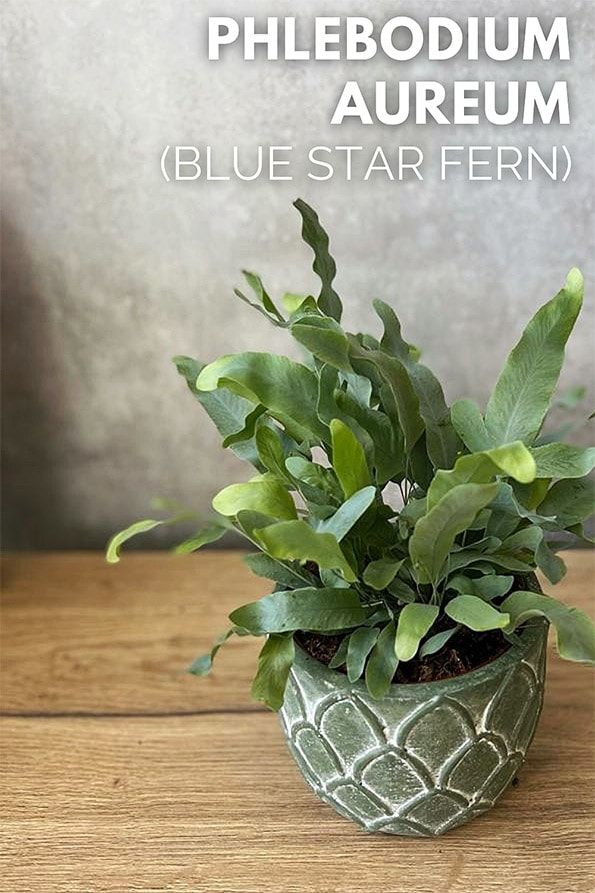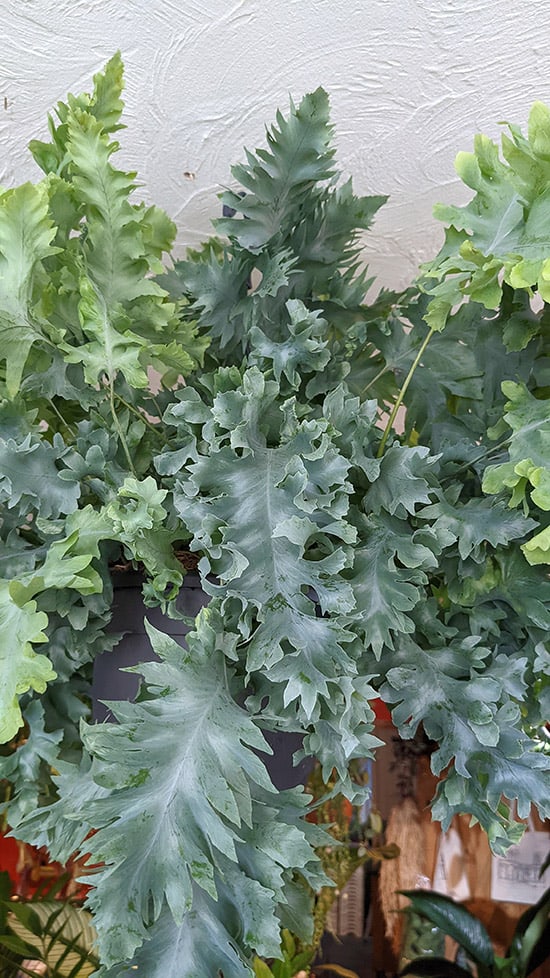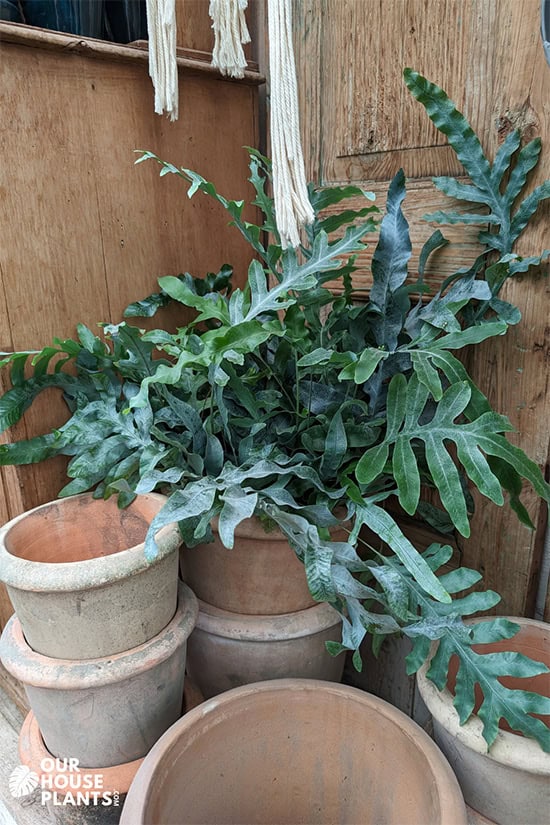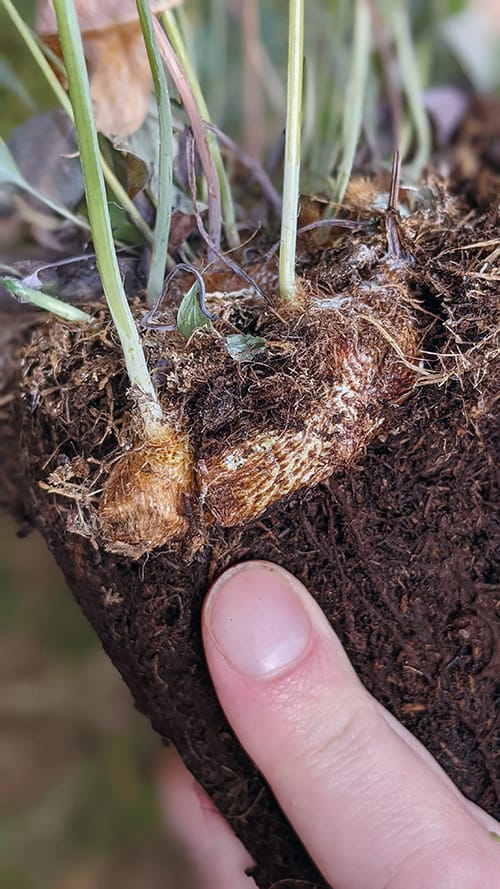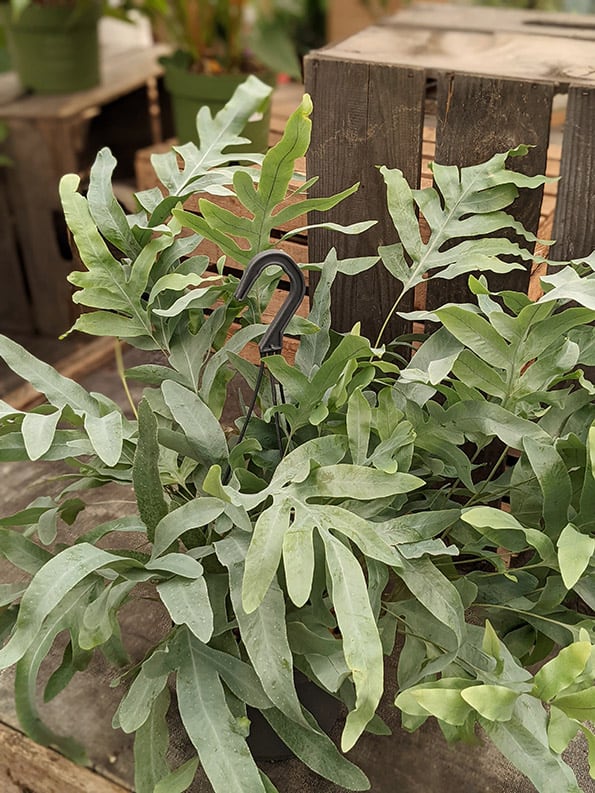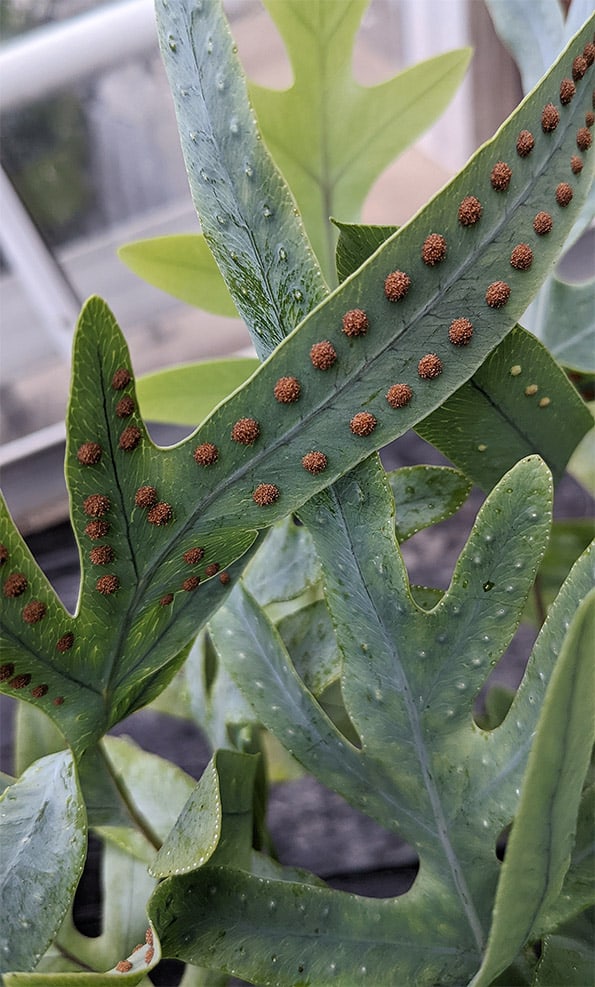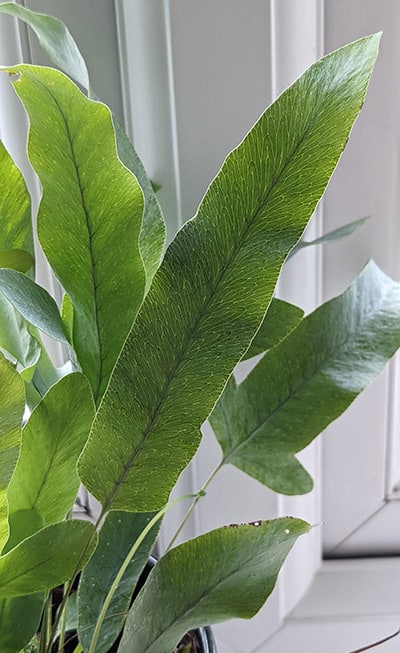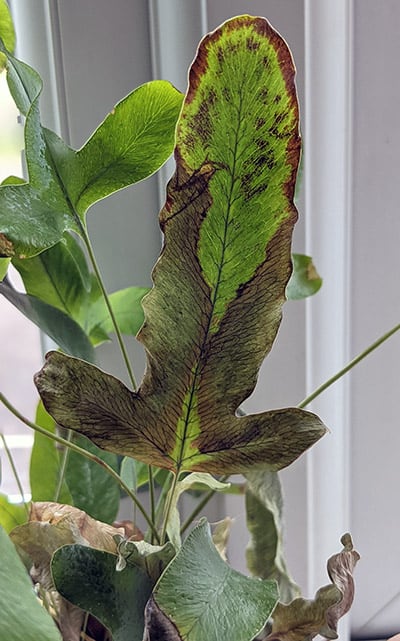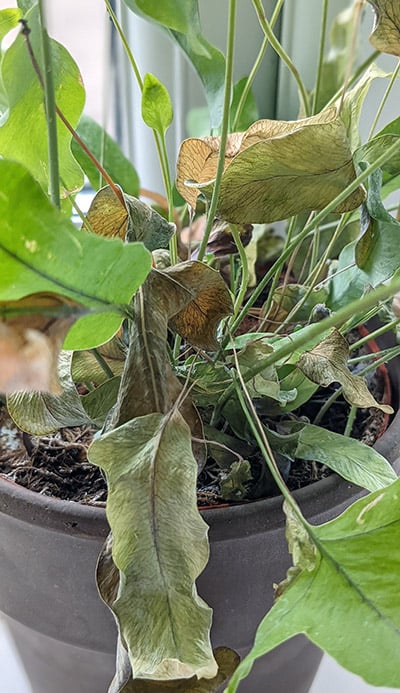The Blue Star Fern or Phlebodium aureum is another beautiful fern that has blue-green foliage in the right light. This houseplant is not particularly fussy and, in my experience, is more resilient than many other ferns grown indoors.
Like the Rabbits Foot Fern, it has creeping furry rhizomes where new leaves will emerge. You can remove these sections to create new plants easily if you want. All in all, it's an easy care indoor plant with few problems, and in most parts of the world, they're fairly inexpensive.
Photo showing the blue-green fronds of the Blue Star Fern. Although it's an epiphytic fern and can grow in a hanging planter, it also does fine in a decorative pot.
It's native to tropical regions of South America, North America and the Caribbean. Hence, it needs a reasonable level of humidity. Still, it's pretty adaptable and will cope with less humid locations if you're careful not to let the growing medium dry out fully.
How do you pronounce Phlebodium aureum correctly? Say:
flee-BOH-dee-um AW-re-um
They also resist pest pressures well. I don't think mine have ever had any problems with them.
They change their appearance over time too, so you always have something "new" to appreciate. Young plants will have very simple and small looking fronds. But over time, as the plant matures, the fronds get a lot bigger, with more detail and complexity with lots of lobes or "fingers".
Common Names
It can be called Golden Polypody, Gold Foot Fern or Hare Foot Fern because of the gold / yellow spreading furry Rhizomes that grow across the soil surface.
I've also heard it being called "Cabbage Palm Fern" which I can't understand. If you have an explanation for this name, share it with me in the comments.
In their native homes, they're epiphyte plants, which means they grow and hold themselves onto other bigger plants. Indoors you can mount them like the Staghorn Fern, but it's much more common to just have them growing in a regular houseplant container or pot.
There are only a handful of Phlebodium aureum varieties you can buy. The Blue Star Fern is the most popular and commonly found in stores. It's a good all rounder and looks great (shown in almost every photo in this article).
The only other type you're likely to encounter easily is Phlebodium aureum 'Davana' (photo below). This one has the same look and growth habit, but the leaves are crinkled and have a ruffled looked. When compact and well grown, it looks almost like the top of a tree canopy from certain angles.
Only a handful of Phlebodium varieties are commonly sold today, this one is Phlebodium aureum 'Davana'
The Blue Star Fern is often confused with the Kangaroo Fern. If you want to learn how the two plants are different, check out this quick write up with photos of the two plants side by side.

Hi, I'm Tom!
If you're like me and enjoy the challenge of growing houseplants and getting them to thrive, then Ourhouseplants can help. This website shares my knowledge and years of growing plants and provides (hopefully) helpful advice on properly caring for your indoor plant friends.
Phlebodiums almost always look best when "pulled" together and tight looking. To get this look you need to provide ample light. Indirect bright light is the best. This would be the brightest spot in your home that doesn't get any direct sunlight.
You can provide a little shade, but they're not shade-loving or low light houseplants. If you grow it in a place like this, the fronds will "reach," and it will have a sparse appearance over time.
As for direct sunlight, I've destroyed one of my plants in full sun by growing it in a hot South West-facing window. It crisped up and quickly became tatty-looking. I've heard from other owners that they provide morning sun and theirs is growing well; however, based on my experience, I'd still advise caution.
How much water?
You want to be watering reasonably often in the growing seasons (Spring, Summer and Fall). If your plant typically dries out quickly, it can cope with a good soaking once or twice a week. Or several "little and often" splashes of water a week.
In Winter cut back, just giving enough to keep the growing medium damp.
Getting the watering requirements down is a must. These are thirsty ferns that need a moist environment and should not be allowed to dry out too much. They want constantly damp or moist soil pretty much all year round.
As soon as the soil surface looks dry, it's time to provide more water. This is really important, if you have low humidity (see below), otherwise you'll run into problems.
It's a plant from the tropics so it's naturally adapted to high humidity levels. But it's really adaptable and can cope with some lower levels providing the soil remains damp pretty much all the time.
If the levels are very low or you struggle to keep it watered properly, you will need to find ways to increase the humidity level (not sure what we're talking about? Check out - Humidity Levels Explained).
Moving them occasionally to a bathroom or misting isn't overly practical. Grouping plants together, a pebble tray / humidity tray and humidifiers are better options.
Further reading -
Is misting my houseplants worthwhile?
They're not overly hungry plants and feeding "when you remember" has worked well for me! If you want a more structured approach, then feed every couple of months with a general houseplant feed, or one higher in nitrogen to encourage more foliage.
Most ferns have the ability to soften hard materials and harsh shapes. Use them in your home to create a homely and cosy space.
Grow it somewhere with a mild or warm temperature all year round. A range between 14°C (57°F) and 24°C (75°F) is ideal.
It can cope with temperatures a little outside of those ranges, but it won't grow. Avoid very cold temperatures as these are tender ferns and not frost hardy.
Like many ferns, the roots are very thin and delicate, almost like a fishnet. Over a few years, they will colonize the growing medium entirely and hold it all together very tightly. You can pull out an established plant and none of the growing medium will break apart. There's a photo a little further down where you can see this.
It's best to think about repotting your plant into a larger pot whenever it gets like this. There is nowhere else for the roots to grow, so in time, you'll notice you're watering in much more frequently, and growth will stop.
Phlebodiums are pretty adaptable, so they will do well in ordinary potting compost, but they also do well in alternative or mixed potting mediums. Whatever you opt for, they do best when the growing medium is free draining and relatively open.
Is my growing medium "heavy"?
Does the pot feel drastically heavier after watering it? If so, then that's considered a heavy growing medium because it retains a large amount of water.
Although these plants like moisture, too much sitting around the roots can be risky, especially when it's cooler.
If you have a very heavy mixture that will hold a large amount of water, you can open it up by adding around 10% (or so) of Perlite, Vermiculite, Gravel or Grit, etc.
A happy and healthy Phlebodium with a bit of maturity will give you two ways to propagate new plants.
The first is via the spores that appear on the underside of leaves from time to time. You simply need to remove them and spread them thinly over a pot filled with moist compost. Cover the pot with a transparent or clear plastic bag and place it somewhere warm with good light (no harsh sun).
Germination can be erratic, but if it's going to work, you should have mini-plants growing within 3 or 4 months. It's a slow process though and if you don't have the patience take a look at the second more reliable Propagation method.
The fuzzy rhizomes at the base of the plant that can be propagated. The photo also shows the compact and neat structure of the ferns root systems.
The second way to create new plants is by a form of division, where you remove sections of the hairy creeping rhizomes. In the photo above, my finger points to a good selection that you can remove. It's a few inches long and has fronds sprouting already.
You need to cut the rhizome with scissors and then lay it upright on a similar growing medium that you need to keep moist. It's important the "cutting" is in constant contact with the soil, so if you need to use bobby pins or something similar to keep it pined in place.
After a few weeks, you should notice new fronds emerging or the rhizome itself growing. All of this is a good sign things are working. A few more months and you will have an established plant.
If you've followed our care guide pointers from each of the sections above, you will get moderately paced growth. It's not super fast, but it's not slow either. More steady and even. A few new fronds every couple of months is average.
The initial smaller leaves will eventually be replaced with more complex looking and bigger leaves. This gives a very full and bushy look.
If the container or pot is big enough, it can grow huge. Several feet high and wide is common for a fully grown Blue Star Fern.
A mature Phlebodium aureum being grown in a hanging basket.
The Blue Star Fern, like all Ferns, doesn't produce flowers at all, you might get spores, but no blooms to see here. They're purely foliage plants.
There have been no reported health issues associated with this houseplant, making it safe to have around cats and people.
On occasion your plant will grow and produce very visible spores on the underside of the fronds that can be shocking when you first notice them. They start off as raised white spots or bumps before becoming dark brown and contrasting heavily with the greeny blue of the leaves. They can also look like pests!
You can easily discount the possibility of pests by looking at how the markings are placed on the fronds. Spores always have a pattern, like you can see in the photo below. a Pest will be more random and sporadic.
Reproductive spores on the undersides of this frond.
The spores are harmless so I don't recommend the effort of trying to remove them (unless you're trying to propagate new plants).
If you suffer from hayfever, then it would probably be easiest to move your plant outside (if it's warm enough) until the spores are naturally shed. They should last a month or two at the most.
Only growing simple leaves.
Only mature plants grow complicated leaves with multiple lobed edges. Young plants will have straightforward leaves, like the one shown in the photo below.
This Blue Fern has a simple leaf shape. But after a growing season or two, the leaves will look quite different.
The complex and reaching fronds will form once the plant establishes and gets older. So, patience is the solution.
Brown Leaves / Fronds.
Brown leaves are quite common and aren't always a "problem".
Brown tips and leaf edges are a common problem usually caused by incorrect moisture levels.
If you're getting a lot of browning or just have a feeling something isn't "right", it's normally the result of:
Root Rot.
Of course, like most houseplants overwatering can be a problem too. They like moisture, but too much of it and you have an over-watered plant on your hands which can develop root rot.
Prevention is the best approach to prevent waterlogged soil issues. Use a free draining potting mix, and if you're prone to making watering mistakes opt for a pot with at least one drainage hole at the bottom.
Most plastic nursery pots will come with these by default, but if not, just be extra careful and drain out any water that's trapped in the pot.
Tatty Looking Blue Star Fern with lots of dead foliage.
A few things could cause this. But in the main, it will be the result of poor care at some point. Usually lack of water is the culprit. Overwatering can sometimes cause issues, but you'll normally have the fronds going black not brown.
Blue Star Fern care is easy to get right, but when it goes wrong this can be the result.
Pests.
Spider mites or Fungus Gnats could be issues as they're more attracted to the soil or growing environments rather than the plants.
However the pest pressures on the Blue Star Fern usually is low. In fact, we've never had anything affect any of our plants at all. The Phlebodium species just seem to be very resistant houseplants!
Some people confuse the natural spores with something sinister, but it's not something to be concerned about at all. You're giving the right plant care and it's not a problem at all.
If you've ever had pests on your Blue Star, then shout out to us in the comments below and share a photo. We'll then update this section.
